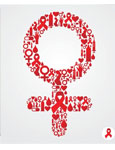Women with HIV-1
 During the “Mens Achter de Cijfers” event on 9 June 2012, women with HIV spoke with SHM researchers about the need for more data related to their demographic group. As a result of these discussions, SHM is looking further into analysing the data of HIV-infected women. According to the Monitoring Report 2011, around a fifth of patients with HIV in the Netherlands and Curacao are women. In this edition of the SHM newsletter, Rebecca Holman and Colette Smit, both researchers at SHM, describe these women and plans for presenting their data in future publications.
During the “Mens Achter de Cijfers” event on 9 June 2012, women with HIV spoke with SHM researchers about the need for more data related to their demographic group. As a result of these discussions, SHM is looking further into analysing the data of HIV-infected women. According to the Monitoring Report 2011, around a fifth of patients with HIV in the Netherlands and Curacao are women. In this edition of the SHM newsletter, Rebecca Holman and Colette Smit, both researchers at SHM, describe these women and plans for presenting their data in future publications.
Demographic characteristics
As of 1st February 2012, 4103 women diagnosed with HIV-1 on or after their 12th birthday had been reported to the SHM. Of these, around two-fifths had been born in Sub-Saharan Africa, a quarter in the Netherlands and a third elsewhere. About a tenth of women were diagnosed with HIV-1 before 1995, half between 1995 and 2004 and just over a third in or after 2005. The number of diagnoses per calendar year rose until 2003 and declined again thereafter. A quarter of women were aged 25 years or younger when they were diagnosed with HIV-1, half between 26 and 38 years and a quarter were older than 38 years. The most probable route of HIV-1 transmission for nearly nine-tenths of women was sexual contact. A third of women reported that they had become infected with HIV-1 in the Netherlands.
The current situation
As of 1st February 2012, nearly one-tenth of the women were known to have died. A quarter of the women who died, died before they were 35 years old, half between the age of 35 and 50 and a quarter over the age of 50 years. Nearly two-fifths of women died of AIDS, one tenth of a non-AIDS defining infection or malignancy and the rest of other or unknown causes.
Three-quarters of the women ever registered by the SHM were still receiving HIV-related care in the Netherlands or Curacao at the start of 2012. Of these, a quarter is aged under 35 years, half between 35 and 49 years and a quarter over 49 years. Half of these women have been HIV-1 positive for less than nine years and half for nine years or longer. Around nine-tenths of the women still receiving HIV-related care has ever used combined antiretroviral therapy.
The future
In this newsletter, we have described the demographic characteristics of the women in the Netherlands and Curacao, who are HIV-1 positive. We are currently working to describe the health status of these women in more depth, particularly with regard to mortality, AIDS diagnoses and non-AIDS defining conditions, such as kidney insufficiency, diabetes, liver disease, heart attack, osteoporosis, stroke and non-AIDS defining malignancies. We hope to present our results in the Monitoring Report 2012, due to be published on World AIDS Day, 1st December 2012.
